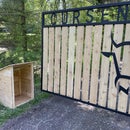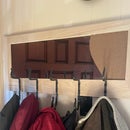Introduction: Bike Frame Bag From a Recycled Sail
This Instructable is about a novice making a bikepacking frame bag from an old sailboat sail. The particular sail I'm using is a sail canvas with a treatment to make it pretty water and wind resistant. The best characteristic of this material is that it doesn't stretch. So, as long as I can attached the bag snuggly to my bike, it shouldn't bulge out in the middle.
I had an upcoming bikepacking trip to some hotsprings, and I really didn't want to pedal 11 miles uphill with a 40 pound pack on my back. I've seen a few online tutorials of people sewing up frame bags from canvas or cordura, and even some no-sew duct tape versions. It looked pretty easy on the internet, so I figured I'd give it a shot.
Now, I'm not the best sewer. I took Home Economics in High School, and I've hemmed some pants for a wedding, but that's about it. But I can appreciate the value of learning a new skill, so I decided to wing it...
Supplies
A ratty ol' Sail Cloth - these can be found at a sail maker's shop or watching the classifieds in a port town. New ones are available on the internet from a variety of sources. They're different than the "sail cloth" you can get at a fabric store.
Heavy Duty Sewing Machine
Scissors
Pencil/Sharpie
Scrap Cardboard for template making
Zipper
Paracord, velcro, or webbing/buckles
Step 1: The Template
The first step is to build a cardboard template that you can use to cut out a custom frame bag shape with.
I removed the water bottle cages, because I'd rather have the room for gear on my bike frame than water. The obvious solution to not having water bottle cages is a camelback style water bladder, or there's like a bazillion different water bottle mounting options... Bikepacking.com has a some solutions on their page.
When putting together a cardboard template, there is no reason to take any measurements. Just hold that guy up there and trace the inside of the bike frame onto it. It should be a loose enough fit that it slips in and out without a problem, but you also don't want to be able to fit a finger all the way around it.
The design:
It seems like you would want to use all of the space available in the front frame triangle, but there are a few things to keep in mind:
First of all, don't crowd the bottom bracket. You don't want the lowest part of the frame bag to bulge into the front derailleur.
Secondly, some people leave a hand-hole just below the seat. You're going to have to pick up your bike to get over downed trees, and it can be a good idea to leave a place to grab your bike frame. Personally, I'm a big guy and not good enough of a sewer to make a curve, so I just pick the bike up by the seat.
Finally, you need to consider attachment points. How are you going to attach the bag to your bike? How are you going to attach your bike to your car, and will that bike rack interfere with the bike bag? For simplicity's sake, I'm sewing in tabs to run some old paracord through, then lacing it onto my bike like a shoelace. My bike rack will absolutely interfere with the bike bag, but I will be using a bike beam bar as a workaround.
Step 2: Cutting the Fabric Panels
An old sail is a pretty big piece of cloth. Mine is a Jib from a buddy's sailboat that was replaced when it starting tearing. The jib is relatively small, but it was still difficult to manage until I split the seams to create smaller pieces.
To split the seams, I clamped the sail to a post on my shop and started pulling against the seam and cutting the threads with a razor knife. This yielded a long strip of about 3 foot wide sail cloth.
I used my cardboard template to trace out the shape of the first panel.
For sewing, the general consensus is to afford an extra half inch all the way around for seams. But I'm pretty bad at sewing, so I gave myself more like 3/4 of an inch.
I used sharpie to mark out where my seams would go so I could see them better while sewing. I'm not concerned with how bold and ugly the sharpie will be once it's finished.
Step 3: First Stitches
I'm using an older Elna sewing machine for this. For the most part, it's capable of going through four layers of sail cloth, but I did run into some issues with the tension on the presser foot not being adequate, resulting in some missed stitches that needed to be redone.
The best stitch for working with sail cloth is a zig zag. This distributes the tension onto a large patch of fabric, minimizing the chances of ripping.
A good-enough stitch is a straight one. Straight ones are easier than zig-zags, so I did that. I used a pretty tight stitch spacing so strength wasn't an issue, but sail cloth can separate if there's too much tension, the seam allowance is too small, and the straight stitch spacing is too tight. Sail cloth is pretty strong until a rip starts. There's no ripstop in the fabric, so a small tear can quickly turn into a large one.
I made ~3-3/4" strips to use as the backbone of the bike bag. After my 3/4" seam allowance, It leaves me with about 2-1/4" wide bike bag. A can of beer is 2-1/8" wide, so this should be about perfect.
I also cut a bunch of little tabs to sew into the seam for lacing the bag onto my bike when it's done. These were where the sewing machine had a difficult time getting through 4 pieces of fabric.
An Iron does wonders getting the material to lay flat enough to easily sew. Heat setting was "Wool".
EVERYTHING IS INSIDE OUT
The most important part about sewing pretty much anything, especially a bag, is that it's inside out. It'll function the other way, but it sure would be ugly.
Step 4: Keep Stitching
I completely stitched the 3-3/4" backbone all the way around the first panel before tracing and cutting the second panel. Why? A lack of confidence. I really didn't expect the first panel to be perfect the first time, but the cardboard template method was pretty accurate.
Still inside out, I stitched the 3-3/4" backbone onto the second panel, while adding the lacing tabs staggered from the ones on the first panel.
The last seam to stitch is the top tube seam. This is where the zipper goes. If I were to stitch this bag all up before putting the zipper in, I'd never be able to turn it inside right. I've seen other people sew the bike bag completely, then cut a hole for the zipper. Since sail cloth has zero ripstop in it, I wanted the zipper to be right on the top seam instead of introducing a spot for a potential tear.
Step 5: Zipping It Up
I've never sewn a zipper on before.
I got this zipper at Walmart for like $4. It was the most expensive part of the bag. I splurged for the heavy duty coat zipper since where I'm putting it, it will have forces trying to pull against the zipper teeth.
I started sewing the zipper onto the easy side - the side of the bag instead of the top. Remember it's still inside out. That's a mistake you can't hide.
The hard side - the top - has the lacing tabs on it. They're longer than they should be for putting them this close to the zipper teeth. They were getting caught when I tried to use the zipper the first time, so the they were immediately cut back so there was less excess inside the bag. All the other ones on the bag (maybe 20-25?) were fine full length. The longer they are, the less apt they are to split, so I didn't want to cut down more than necessary.
Step 6: Does It Fit?
After getting the zipper on, it's time to flip in inside right and test fit it.
It fit better than I expected.
I did rip out a stitch after I laced it onto the bike, so I had to take it off, flip it inside out again, add some stitching, and re-lace it onto the bike. Lacing it onto the bike takes a lot longer than I expected.
I ran the lacing between the frame and shift/brake cables. It did not affect shifting or braking in any noticeable way.
The lace I used is a single piece of old 550 paracord.
Step 7: Using It and Final Thoughts
It worked really well. It's narrow, so there isn't too much storage space, but it took some weight off my back. I was able to fill it with: 2 cable locks, a coffee mug, inflatable sleeping pad, inflatable pillow, 4 beers, and a pack towel.
Lacing it onto the bike was time consuming. Once on, it's staying on for a while. This isn't something I'm going to put on at the trailhead.
It never interfered with my pedalling. No knee-rub, and it didn't bulge out at all. The sail cloth was stiff, and the lacing kept the big side panels nice and tight.

Participated in the
Recycled Speed Challenge













